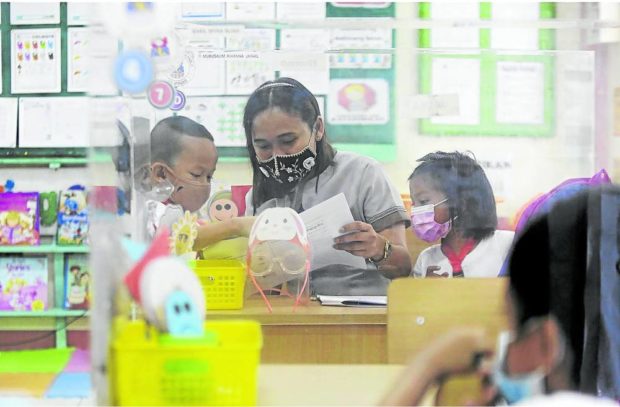
BACK IN SCHOOL, BUT . . . Two kinder pupils confer with their teacher in Manila. —RICHARD A. REYES
A new Italian study suggests that COVID-19 spreads far more easily in schools than in the community, and concluded that “uncontrolled COVID-19 transmission in schools could disrupt the regular conduct of teaching activities” and seed the transmission into other settings.
The comprehensive contact tracing study, published Sept. 20 in the “Influenza and Other Respiratory Viruses” journal, shows that children in schools are a major source of transmission among students, while household spread is a major amplifier of infection.
The study analyzed transmission patterns associated with 976 SARS-CoV-2 exposure events involving 460 positive individuals in 2021 in the Italian municipality of Mede in the Lombardy region.
From a small town
The data were taken from routine surveillance and an extensive screening conducted on students, school personnel and their household members in the small municipality with more than 6,000 inhabitants.
“Despite protocols in place to curb SARS-CoV-2 transmission during in-person school attendance, our analysis suggests that younger age groups were deeply involved in the spread of the infection,” according to the results of the study.
The analysis also suggests that approximately 50 percent, 21 percent and 29 percent of COVID-19 transmission was associated with household, school and community contacts, respectively.
But in terms of transmission chain, the study found out that clusters originating from students or school personnel were associated with a larger average cluster size and a larger average number of generations in the transmission chain.
Close monitoring
The study recommended a close monitoring of the epidemiological situation in schools, with the “persistent circulation of SARS-CoV-2 and the shift of the age of cases toward younger ages observed throughout Europe in 2022.”
A similar study, however, has yet to be conducted in the Philippines.
Without disclosing the number of infections, the Department of Education (DepEd) had recently confirmed the reported COVID-19 cases in campuses a month after school opening.
Strategies needed
Last month, the DepEd issued Department Order No. 39, urging regional school directors to “strategize for the implementation and operationalization” of health and safety protocols in their respective regions and schools.
But the Alliance of Concerned Teachers called the DepEd’s COVID-19 prevention policy a “recipe for disaster” for lacking substantive measures to reduce risks of infection in schools, such as providing necessary health facilities, equipment, supplies and personnel.